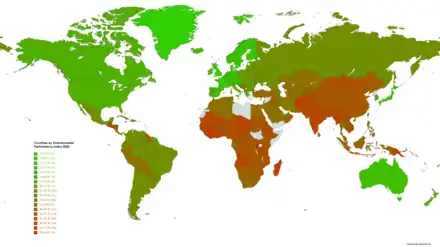
The Environmental Performance Index (EPI) is a method of quantifying and numerically marking the environmental performance of a state's policies. This index was developed from the Pilot Environmental Performance Index, first published in 2002, and designed to supplement the environmental targets set forth in the United Nations Millennium Development Goals.[1]
The EPI was preceded by the Environmental Sustainability Index (ESI), published between 1999 and 2005. Both indices were developed by Yale University (Yale Center for Environmental Law and Policy) and Columbia University (Center for International Earth Science Information Network) in collaboration with the World Economic Forum and the Joint Research Centre of the European Commission. The ESI was developed to evaluate environmental sustainability relative to the paths of other countries. Due to a shift in focus by the teams developing the ESI, the EPI uses outcome-oriented indicators, then working as a benchmark index that can be more easily used by policy makers, environmental scientists, advocates and the general public.[2] Other leading indices like the Global Green Economy Index (GGEI)[3] provide an integrated measure of the environmental, social and economic dynamics of national economies. The GGEI utilizes EPI data for the environmental dimension of the index while also providing a performance assessment of efficiency sectors (e.g. transport, buildings, energy), investment, green innovation and national leadership around climate change.
The EPI for the year 2022 ranks 180 countries. The top five countries are Denmark, United Kingdom, Finland, Malta and Sweden.[4] India ranked last at 180 with a score of 18.9.[5][6]
Methodology
EPI calculation variables change often as can be seen below. This should be taken into account when observing country performance through several reports, as it can lead to score and ranking changes founded just on methodology modification. Apart from variables addressing environmental health and ecosystem vitality, the calculation also takes into account other variables such as rule of law, control of corruption and government effectiveness.[5]
2020 variables
| Objective[7] | Issue Category | Indicator |
|---|---|---|
| Environmental health (40%) | Air quality (65%) | Air pollution - Household Solid Fuels (40%) |
| Air pollution - Average Exposure to PM2.5 (30%) | ||
| Air pollution - PM2.5 Exceedance (30%) | ||
| Water Quality (30%) | Unsafe Sanitation (50%) | |
| Drinking Water Quality (50%) | ||
| Heavy metals (5%) | Lead Exposure (100%) | |
| Ecosystem vitality (60%) | Biodiversity and habitat (25%) | Marine Protected Areas (20%) |
| Biome Protection (Global) (20%) | ||
| Biome Protection (National) (20%) | ||
| Species Protection Index (20%) | ||
| Representativeness Index (10%) | ||
| Species Habitat Index (10%) | ||
| Forests (10%) | Tree Cover Loss (100%) | |
| Fisheries (10%) | Fish Stock Status (50%) | |
| Regional Marine Trophic Index (50%) | ||
| Climate and energy (30%) | CO2 Emissions (Total) (50%) | |
| CO2 Emissions (Power) (20%) | ||
| Methane Emissions (20%) | ||
| N2O Emissions (5%) | ||
| Black Carbon Emissions (5%) | ||
| Air Pollution (10%) | SO2 Emissions (50%) | |
| NOX Emissions (50%) | ||
| Water resources (10%) | Wastewater treatment (100%) | |
| Agriculture (5%) | Sustainable Nitrogen management (100%) |
2018 variables
The variables in 2018 are largely similar to those from 2016, but have changed in details and some weights. Notably environmental Health is now weighted at 40% and ecosystem vitality at 60%.[8]
| Objective | Issue Category | Indicator |
|---|---|---|
| Environmental health (40%) | Health Impacts (33%) | Environmental Risk Exposure (100%) |
| Air quality (33%) | Household Air Quality (30%) | |
| Air pollution - Average Exposure to PM2.5 (30%) | ||
| Air pollution - PM2.5 Exceedance (30%) | ||
| Air pollution - Average Exposure to NO2 (10%) | ||
| Water and sanitation (33%) | Unsafe Sanitation (50%) | |
| Drinking Water Quality (50%) | ||
| Ecosystem vitality (60%) | Water resources (25%) | Wastewater treatment (100%) |
| Agriculture (10%) | Nitrogen use efficiency (75%) | |
| Nitrogen balance (25%) | ||
| Forests (10%) | Change in forest cover (100%) | |
| Fisheries (5%) | Fish stocks (100%) | |
| Biodiversity and habitat (25%) | Terrestrial Protected Areas (National Biome Weights) (20%) | |
| Terrestrial protected areas (Global Biome Weights) (20%) | ||
| Marine protected areas (20%) | ||
| Species protection (National) (20%) | ||
| Species protection (Global) (20%) | ||
| Climate and energy (25%) | Trend in carbon intensity (75%) | |
| Trend in CO2 emissions per kWh (25%) |
EPI scores
2022
The Environmental Performance Index for the year 2022 ranks 180 countries.[9]
Top 100 countries and score
 Denmark 77.9
Denmark 77.9 United Kingdom 77.7
United Kingdom 77.7 Finland 76.5
Finland 76.5 Malta 75.2
Malta 75.2 Sweden 72.7
Sweden 72.7 Luxembourg 72.3
Luxembourg 72.3 Slovenia 67.3
Slovenia 67.3 Austria 66.5
Austria 66.5.svg.png.webp) Switzerland 65.9
Switzerland 65.9 Iceland 62.8
Iceland 62.8 Netherlands 62.6
Netherlands 62.6 France 62.5
France 62.5 Germany 62.4
Germany 62.4 Estonia 61.4
Estonia 61.4 Latvia 61.1
Latvia 61.1 Croatia 60.2
Croatia 60.2.svg.png.webp) Australia 60.1
Australia 60.1 Slovakia 60
Slovakia 60 Czech Republic 59.9
Czech Republic 59.9 Norway 59.3
Norway 59.3.svg.png.webp) Belgium 58.2
Belgium 58.2 Cyprus 58
Cyprus 58 Italy 57.7
Italy 57.7 Ireland 57.4
Ireland 57.4 Japan 57.2
Japan 57.2 New Zealand 56.7
New Zealand 56.7 Spain 56.2
Spain 56.2 Bahamas 56.2
Bahamas 56.2 Greece 56.2
Greece 56.2 Romania 56
Romania 56 Lithuania 55.9
Lithuania 55.9 Seychelles 55.6
Seychelles 55.6 Hungary 55.1
Hungary 55.1 North Macedonia 54.3
North Macedonia 54.3 Botswana 54
Botswana 54
EPI report archive
Below is a list of links to the archive of past reports
- 2022 EPI full report rankings and scores (page xii)
- 2020 EPI full report rankings and scores (page xii)
- 2018 EPI full report rankings and scores (page vii)
- 2016 EPI full report rankings and scores (page vii)
- 2014 EPI full report rankings and scores (pages 115 - 117)
- 2012 EPI summary rankings and scores (page 6)
- 2010 EPI summary rankings and scores (page 4)
- 2008 EPI summary rankings and scores (page 4)
- 2006 EPI summary rankings and scores (page 5)
Criticisms
The methodology for the EPI has been criticized for its arbitrary choice of metrics which could introduce bias, and its poor performance as an indicator for environmental sustainability.[10] Additional criticisms center on the EPI's lack of specific policy suggestions, and the index's weighting biases against data deficient countries that has led to the overlooking of ecological progress in developing countries. Below is a quote from the abstract:
- Jordan spent 2001–2006 in a node represented by lower life expectancy due to particulate matter emissions (PME), but, from 2007 to 2010, the country shifted to a node with a lower PME magnitude—indicating a positive shift in overall environmental sustainability. By following the EPI ranking, the policymakers in Jordan may have assumed that their decisions between 2006 and 2008 led to a deterioration in environmental sustainability, when, in fact, the inconsistent nature of the weighting process involved in the EPI rankings is a likely cause...[10]
In 2022, India was ranked last in the list and rejected the low ranking. As per a statement issued by the Ministry of Environment, Forests and Climate Change (MoEF&CC), it claimed that several indicators used in the calculation were based on unfounded assumptions and unscientific methods.[11][12][13]
See also
References
- ↑ "Environmental Performance Index". Yale Center for Environmental Law & Policy, and Center for International Earth Science Information Network at Columbia University. Retrieved 16 March 2008.
- ↑ "2008 Environmental Performance Index Report" (PDF). Yale Center for Environmental Law & Policy / Center for International Earth Science Information Network at Columbia University. Archived from the original (PDF) on 9 April 2008. Retrieved 18 March 2008. See Executive Summary, pp. 32-35 for a detailed comparison between the ESI 2005, the EPI 2006 and the EPI 2008.
- ↑ "2016 Global Green Economy Index (GGEI)" (PDF).
- ↑ "2022 EPI Results". Environmental Performance Index. Retrieved 9 June 2022.
- 1 2 "Explained: What Is The Environmental Performance Index And Why India Has Rejected The Report". IndiaTimes. 8 July 2022.
- ↑ P'rayan, Albert (23 July 2022). "Why we need climate change education". The Hindu.
- ↑ "EPI 2020 variables".
- ↑ "EPI 2018 variables".
- ↑ "2022 EPI Results". Environmental Performance Index. Retrieved 22 November 2020.
- 1 2 Kanmani, Aiyshwariya; Obringer, Renee; Rachunok, Benjamin; Nateghi, Roshanak (11 January 2020). "Assessing Global Environmental Sustainability Via an Unsupervised Clustering Framework". Sustainability. 12 (2): 563. doi:10.3390/su12020563. Retrieved 15 May 2021.
- ↑ Banerjee, Ankush. "What Happened to Green India? Ranked Lowest as per Environmental Performance Index, India Disputes Methodology". Business Insider.
- ↑ "India's lagging sustainability performance". Hindustan Times. 27 June 2022.
- ↑ Roy, Esha (11 June 2022). "Explained: What is the environment index, and why has India questioned it?". The Indian Express.
External links
- Yale University – EPI – A collaboration between Yale and Columbia Universities
- Yale University – YCELP – Yale Center for Environmental Law & Policy
- 2018 Environmental Performance Index